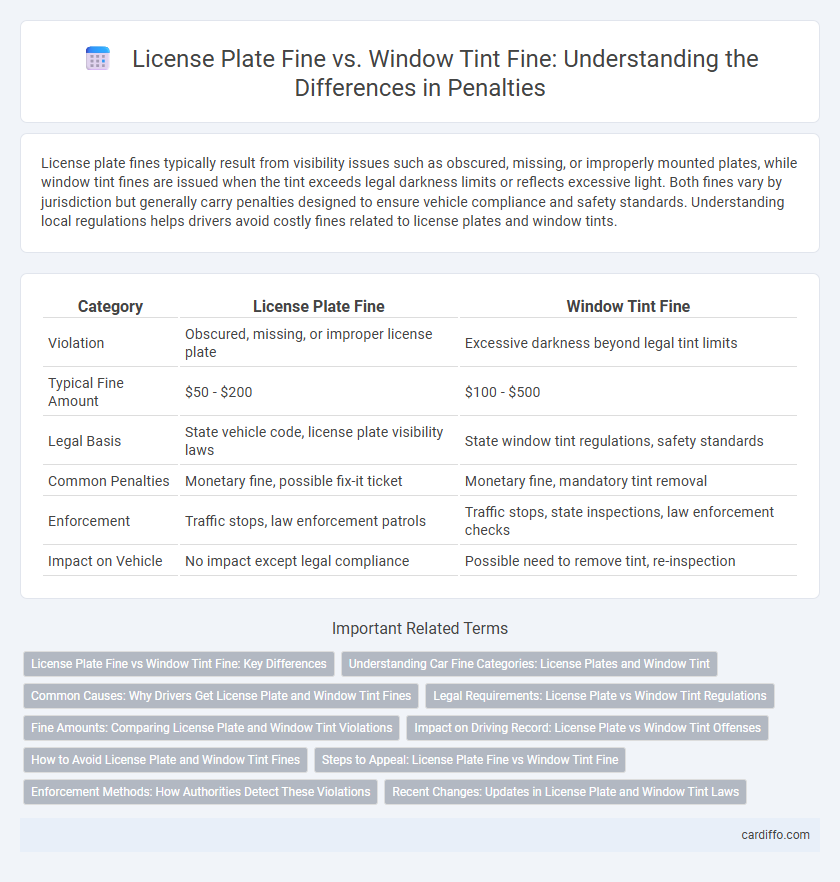License plate fines typically result from visibility issues such as obscured, missing, or improperly mounted plates, while window tint fines are issued when the tint exceeds legal darkness limits or reflects excessive light. Both fines vary by jurisdiction but generally carry penalties designed to ensure vehicle compliance and safety standards. Understanding local regulations helps drivers avoid costly fines related to license plates and window tints.
Table of Comparison
| Category | License Plate Fine | Window Tint Fine |
|---|---|---|
| Violation | Obscured, missing, or improper license plate | Excessive darkness beyond legal tint limits |
| Typical Fine Amount | $50 - $200 | $100 - $500 |
| Legal Basis | State vehicle code, license plate visibility laws | State window tint regulations, safety standards |
| Common Penalties | Monetary fine, possible fix-it ticket | Monetary fine, mandatory tint removal |
| Enforcement | Traffic stops, law enforcement patrols | Traffic stops, state inspections, law enforcement checks |
| Impact on Vehicle | No impact except legal compliance | Possible need to remove tint, re-inspection |
License Plate Fine vs Window Tint Fine: Key Differences
License plate fines typically result from obscured, missing, or improperly displayed plates and are enforced to maintain vehicle identification clarity, while window tint fines arise from exceeding legal tint darkness or reflectivity limits to ensure driver visibility and safety. The severity of license plate fines often depends on the jurisdiction and the specific violation, whereas window tint fines vary based on the percentage of light transmission allowed. Both fines serve distinct regulatory purposes: license plate fines uphold law enforcement identification, and window tint fines promote road safety and compliance with vehicle equipment standards.
Understanding Car Fine Categories: License Plates and Window Tint
Understanding car fine categories involves recognizing that license plate fines typically arise from issues like missing, obscured, or improperly displayed plates, which impede vehicle identification. Window tint fines are enforced when the tint percentage exceeds legally allowed limits, affecting driver visibility and safety. Both categories aim to ensure compliance with traffic regulations and promote road safety by maintaining clear vehicle identification and visibility standards.
Common Causes: Why Drivers Get License Plate and Window Tint Fines
License plate fines commonly result from obscured, damaged, or missing plates, making identification difficult for law enforcement. Window tint fines typically arise when window films exceed legal darkness limits, impairing driver visibility and police observation. Both violations frequently occur due to lack of awareness of specific state regulations regarding vehicle appearance standards.
Legal Requirements: License Plate vs Window Tint Regulations
License plate fines result from non-compliance with state-specific display and visibility regulations, such as improper mounting or obscured plates, which are legally required for vehicle identification and law enforcement. Window tint fines arise when the tint percentage exceeds the legal limits set by state laws, designed to ensure driver visibility and safety. Both fine categories enforce adherence to distinct legal requirements to maintain road safety and regulatory standards.
Fine Amounts: Comparing License Plate and Window Tint Violations
License plate fines typically range from $50 to $200 depending on the state, while window tint violation fines can be significantly higher, often between $100 and $500. The variance in fine amounts reflects stricter regulations on window tinting due to safety concerns and law enforcement visibility requirements. Some states impose additional penalties or require removal of illegal tint, leading to increased overall costs compared to license plate infractions.
Impact on Driving Record: License Plate vs Window Tint Offenses
License plate fines typically result in points added to a driver's record, directly impacting insurance rates and driving privileges. Window tint fines often lead to citations without points, causing less severe effects on the driving record but may require removal or correction of the tint. Understanding the legal distinctions helps drivers manage penalties and maintain a clean driving history.
How to Avoid License Plate and Window Tint Fines
To avoid license plate fines, ensure your license plate is securely attached, clearly visible, and free from obstructions or damage, complying with state regulations on size and illumination. For window tint fines, check that your window tint percentages meet your state's legal limits, often requiring a minimum visible light transmission (VLT) for front and side windows. Regularly inspect your vehicle for compliance with local vehicle codes and update any modified features to match legal standards to prevent fines effectively.
Steps to Appeal: License Plate Fine vs Window Tint Fine
To appeal a license plate fine, gather evidence such as photos, proof of registration, and any relevant documentation, then submit a formal appeal to the issuing authority, often through an online portal or in-person hearing. For a window tint fine, collect manufacturer specifications, tint certification, and photos showing compliance levels before filing an appeal with the traffic court or local DMV. Understanding local laws and deadlines for submitting appeals is critical for both types of violations to increase the chances of a successful outcome.
Enforcement Methods: How Authorities Detect These Violations
Authorities enforce license plate fines using automated license plate recognition (ALPR) systems and roadside inspections to detect obscured, missing, or altered plates. Window tint violations are identified through visual inspections by officers equipped with specialized tint meters that measure the light transmission percentage to ensure compliance with legal standards. In some regions, fixed cameras and mobile units enhance detection efficiency for both offenses during routine traffic stops and surveillance.
Recent Changes: Updates in License Plate and Window Tint Laws
Recent changes in license plate laws include stricter visibility requirements and updated mounting height regulations aimed at enhancing law enforcement recognition. Window tint fines have increased due to revised permissible tint levels and expanded vehicle categories subject to regulation. These updates reflect a broader effort to improve road safety and compliance through clearer enforcement standards.
License plate fine vs Window tint fine Infographic

 cardiffo.com
cardiffo.com